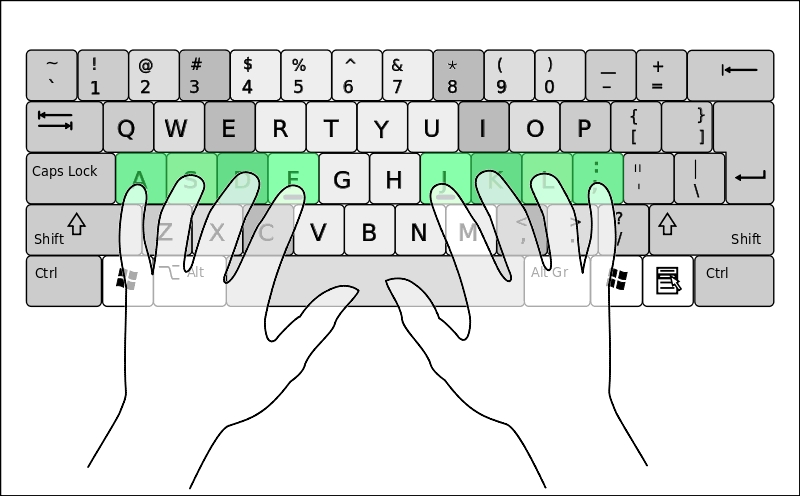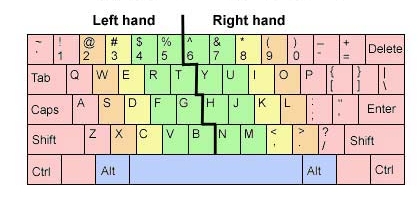

TOP TIP: After the age of seven most kids can use a normal keyboard comfortably but may be more efficient and faster with a child-size model.
#Typing fingers which keys how to#
Children who are learning how to touch-type and are under the age of ten may also benefit from a child-size keyboard that allows them to reach the keys more easily. These may be particularly useful for typists who struggle to type a key without pressing neighboring letters or who have difficulty seeing the letters printed on keys. Keyboards come in different shapes, sizes, and layouts and you can also purchase accessories such as overlay mats and metal key-guards to enhance the typing experience. The best keyboard will depend on the size of your hands, any motor-skills difficulties or visual impairments you struggle with, how frequently you plan to use it, and your approach to typing – specifically if you hunt-and-peck or touch-type. Ctrl + F5: Refresh the web page and delete the existing data in the Cache.There are a number of points to consider when you’re looking for a new keyboard and because every individual has different needs, there’s no one size fits all solution. Ctrl + R: Refresh the data currently displayed from a website.Ħ1. Ctrl + N: Create a new web browser window.Ħ0.

Ctrl + L: Displays the dialog box to enter the address of the website to access.ĥ9. Ctrl + I: Open the directory to manage your favorite address.ĥ8. Ctrl + F: Smart search on open website.ĥ7. Ctrl + E: Move to the browser search bar.ĥ5. Ctrl + B: Open the list of favorite browser addresses.ĥ4. Keyboard shortcuts for Internet Explorer (IE)ĥ3. Ctrl + F10: Zoom in / out the application window.ĥ2. Ctrl + P: Call the printing feature from the running application.ĥ1. Alt + F: Displays a menu list from the current window.ĥ0. Ctrl + S: Save over the existing data file.ĩ. Press Shift 5 times: Turn off / open StickyKeys either. Left Alt + Right Shift + Numlock: Turn on / off MouseKeys.Ĥ4. Left Alt + Left Shift + Print Screen: Turn off / open High Contrast.Ĥ3. Hold down the right Shift key for 8 seconds: Turn on / off FilterKeys.Ĥ2.
#Typing fingers which keys windows#
Windows + U: Open Ease of Access Center in Control Panel. Windows + L: Return to the lock screen.Ĥ0. Windows + F1: See the operating information of the operating system.ģ8. Ctrl + Windows + F: Search for data in My Computer.ģ7. Windows + M: Minimize the current window to the taskbar.ģ6. Windows + Break: Open the System Properties window. Tab: Move between components on the window. F1: Open the help section of a software.ģ0. Enter: Confirm the entered data instead of the program buttons like OK. Ctrl + Shift + Tab: Move between browser tabs in order from right to left.Ģ8. Ctrl + Tab: Move between tabs of the browser in order from left to right.Ģ7. Hold down the Shift key when you insert the disc into the optical drive: Don't let the "autorun" feature of the CD / DVD automatically activate.Ģ6. Backspace: Return to the previous list, similar to Undo.Ģ5. F5: Refresh the icons in the current window.Ģ4. Alt + click: Move quickly to a part of the text from the table of contents.Ģ3. Ctrl + Esc: Open Start Menu, replace Windows key. F4: Open the list of addresses in the Address section of My Computer.Ģ1. Alt + Esc: Select an order of another active window to work.Ģ0. Alt + Tab: Switch between programs runningġ9. Ctrl + F4: Close the current window of the currently executing program.ġ8. Alt + Enter: Open the Properties window of the currently selected file / folder.ġ7. F3: Open the file / folder search feature in My Computer.ġ5. Ctrl + scroll key: Move the cursor to the beginning of the previous paragraph.ġ4. Ctrl + scroll key: Move the cursor to the beginning of the next paragraph.ġ2. Ctrl + left scroll key: Move the mouse pointer over the first character of the previous word.ġ1.

Ctrl + scroll key right: Move the mouse pointer to the end of the word that is behind it.ġ0. Ctrl + Shift + use mouse to drag: Create shortcut for selected file / folder.ĩ. Ctrl + Shift + a scroll key (left / right / up / down): Select multiple files / folders continuously.Ĩ. Ctrl + a scroll key (left / right / up / down): Select multiple discrete files / folders.ħ. Shift + Delete: Delete files / folders straight away without keeping them in the trash.Ħ. Ctrl + Z: Return to the previous time (Undo).ĥ. 63 of the many useful keyboard shortcuts on the following are what you need to remember. then mastering the Shortcuts will be extremely necessary. Especially for those who often work with computers such as accountants, programmers, designers or students who are trying to practice skills of typing 10 fingers before starting a job application. Shortcuts help users to use computers more efficiently by combining keys to call a certain feature instead of having to manually select, while saving you considerable time.


 0 kommentar(er)
0 kommentar(er)
